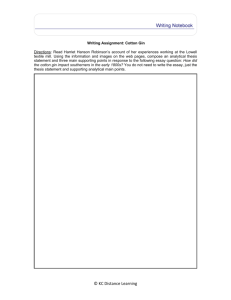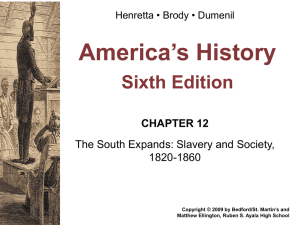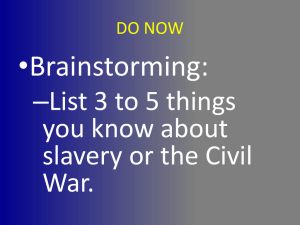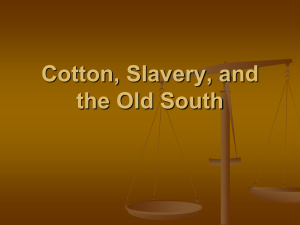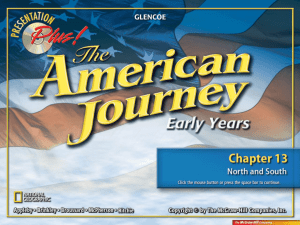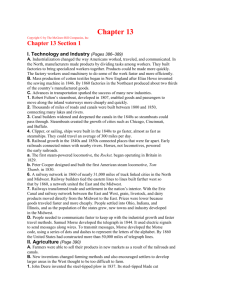Chapter 16 Sectional Differences (1820
advertisement
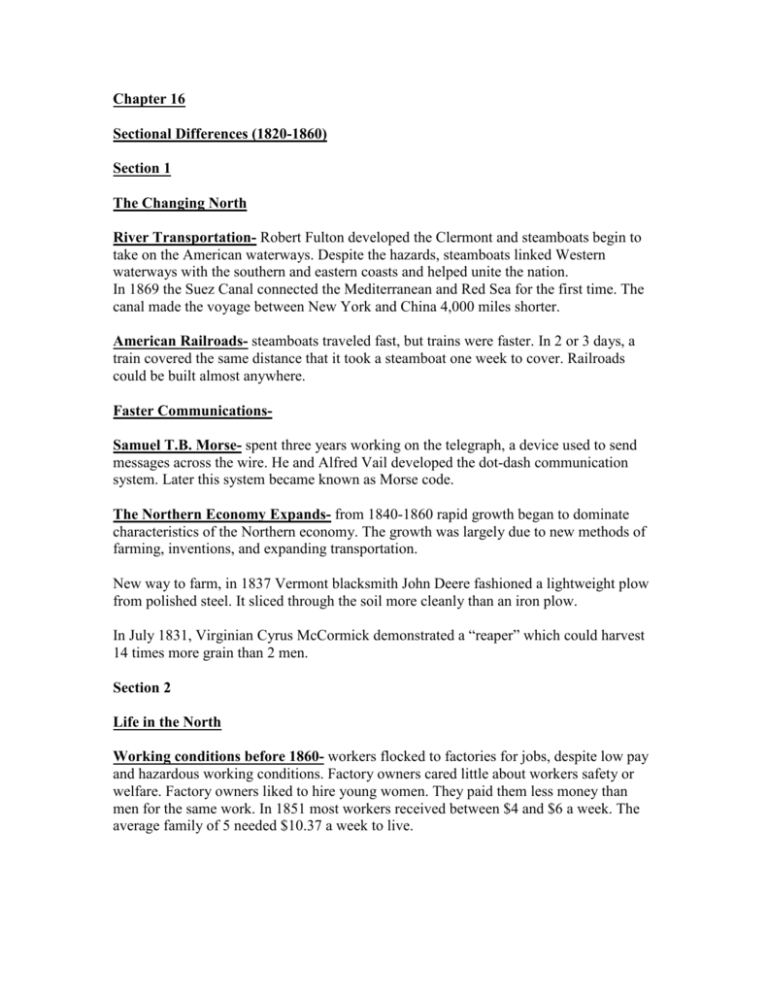
Chapter 16 Sectional Differences (1820-1860) Section 1 The Changing North River Transportation- Robert Fulton developed the Clermont and steamboats begin to take on the American waterways. Despite the hazards, steamboats linked Western waterways with the southern and eastern coasts and helped unite the nation. In 1869 the Suez Canal connected the Mediterranean and Red Sea for the first time. The canal made the voyage between New York and China 4,000 miles shorter. American Railroads- steamboats traveled fast, but trains were faster. In 2 or 3 days, a train covered the same distance that it took a steamboat one week to cover. Railroads could be built almost anywhere. Faster CommunicationsSamuel T.B. Morse- spent three years working on the telegraph, a device used to send messages across the wire. He and Alfred Vail developed the dot-dash communication system. Later this system became known as Morse code. The Northern Economy Expands- from 1840-1860 rapid growth began to dominate characteristics of the Northern economy. The growth was largely due to new methods of farming, inventions, and expanding transportation. New way to farm, in 1837 Vermont blacksmith John Deere fashioned a lightweight plow from polished steel. It sliced through the soil more cleanly than an iron plow. In July 1831, Virginian Cyrus McCormick demonstrated a “reaper” which could harvest 14 times more grain than 2 men. Section 2 Life in the North Working conditions before 1860- workers flocked to factories for jobs, despite low pay and hazardous working conditions. Factory owners cared little about workers safety or welfare. Factory owners liked to hire young women. They paid them less money than men for the same work. In 1851 most workers received between $4 and $6 a week. The average family of 5 needed $10.37 a week to live. Just to make ends meet, many children also had to work. In 1832, children made up about one-third of the nation’s factory workers. They worked 12 hours a day for 6 days a week. Often they made as little as 11 cents a day. Workers organize-workers in 1850 started to organize labor unions, or organizations that improve working organization and pay. Strikes- means that the workers refuse to do their jobs until employers meet their demands. Most early strikes failed. Because strikes were illegal strikers faced fines and jail sentences. Women workers faced special challenges. They earned less money than men and most union leaders would not allow women to join. Workers from across the ocean Immigrants- people come to a country with the intentions of living there permanently. By 1860 one out of every eight Americans had been born elsewhere. Most come from Europe. German Immigrants- in 1860 there were about 1.3 million German Immigrants in U.S. Many stayed in New York. Many became farmers. Irish Immigrants- an even larger group about 40% of all immigrants came from Ireland. Between 1845 and 1854 a disastrous blight and disease ruined several potato crops. Rather than starve, many survivors choose to come to America. The immigrants supplied much of the unskilled labor needed to build the North’s growing industries. Over time immigrants assimilated or adopted the manners and language of their new country. Immigrants Face Resentment- many American born people disturbed anyone different from themselves. They did not welcome the newcomers. Two reasons for hatred: 1) they feared the immigrants were willing to work for less money; 2) they resented their different language, customs and religions. Know-Nothing Party- to get what they wanted natives formed a new political party, the American party. This group hated Irish, German, Catholic, and blacks. Many violent acts were committed by this group against different minorities and when asked about it, they simply replied we know-nothing. African-Americans in the North- thousands of African Americans lived in the North. Although they had been freed, many faced discrimination in the northern states. Discrimination occurs when certain groups of people are not treated fairly. Most African Americans could not ride in the same carriage or work in the same building with a white person. Good jobs were seldom open to them. Although denied voting rights, African Americans fought bravely in every American war, published their own newspapers and founded their own churches. Many also contributed time and money to the anti-slavery movement. Section 3 The Cotton Kingdom- between 1820 and 1860, the North became increasingly urban and industrialized, meanwhile the South remained largely agricultural with few large cities. As a result, the South had to purchase most of its manufactured goods from the North. The South had 7 cities with a population of over 8,000 in 1820. By 1850 just 12 cities over a population had more than 10,000 people, New Orleans 150,000. Yeomanry- a family running a small farm made up the majority in the south. The Cotton Gin- the demand for cotton increased in Great Britain and the northern United States as the results of the Industrial Revolution. As textile mills produced cheaper goods faster, they needed more cotton; the south required a faster way of removing the seeds. In 1793 a Yale graduate named Eli Whitney visited Catherine Greene at her plantation in Georgia. Mrs. Greene explained to Eli that they needed a machine that could separate the seeds from the fiber. Whitney invented the cotton gin. A worker using a cotton gin could process 50 pounds of cotton, rather than 1 pound per day. People began to say that cotton was king in the south. Cotton became the south’s biggest cash crop, and the chief export of the U.S. In 1860 cotton made up 57% of all exports from the U.S. Northerners profited from the cotton boom, too. The south shipped much of its raw cotton to the North. There northerners used it to manufacture cloth and often sold the cloth back to the south. Slavery Revived- with Eli Whitney’s invention of the cotton gin, slave labor became profitable again throughout the south. When cotton production rose, the demand for enslaved persons increased. In 1790 a field hand cost between $300 and $350. By 1860 the average cost was $1,500.00. Slave traders made tremendous profits. A typical dealer in Memphis earned $96,000 in a year. Section 4 Life in the South Southern class structure- the presence of slavery affected all aspects of southern life. Yet only about one-fourth of all white southerners held slaves. Small farmers held less than 20 slaves. The Planters- the owners of large plantations held the highest positions in southern society. Wealthy planters cultivated the best land and enslaved 50 to 200 or more people. Overseer- these people would direct the slave. The Yeomanry- ranked just below the planters in southern society. This class of farmers and ranchers made up a large part of the south’s population. Poor Whites- stood at the bottom of white society in the south. They rented their land, often paying the rent with part of their crops. Free African Americans- occupied a position in southern society lower than poor whites. About 200,000 free African Americans lived in the south around 1850. Free African Americans, in both the north and the south, suffered harsh treatment at the hands of whites. In the south they had to register, wear a special badge, pay special taxes, and live in separate areas from whites. The Life of an Enslaved Person- most enslaved persons however, labored in the fields tending tobacco, cutting sugarcane, or picking cotton. Most were punished with a lash. Slave Codes- were made to control enslaved people. Slave codes denied slaves basic human rights. Slaves codes: 1. No standing in a court of law 2. Could not testify against a white person 3. Could not own property 4. Slaves could not leave their plantations without permission 5. They could not own guns 6. They could not hire themselves out or by and sell goods 7. Could not learn to read or write it was against the law 8. Could not strike a white person even in self defense Families, Religion and Resistance- southern law did not recognize slave marriages as permanent because the husband and wives were often separated. Grandparents, aunts, uncles, and cousins stuck together. Extended family- this provided them strength, pride and love. Armed ResistanceNat Turner Revolt



